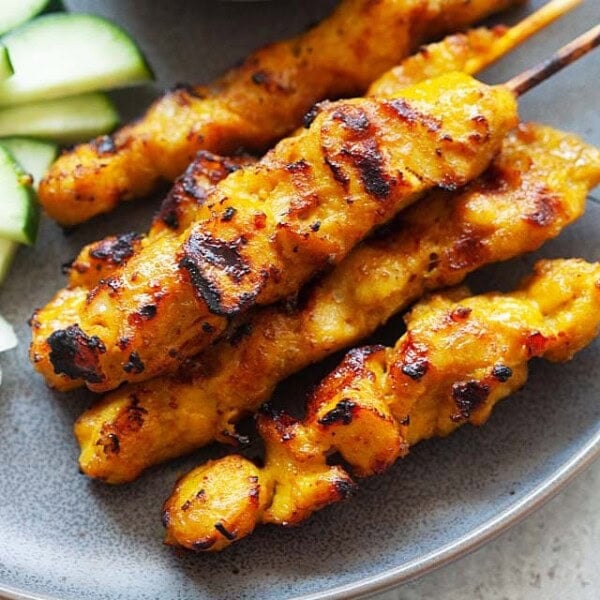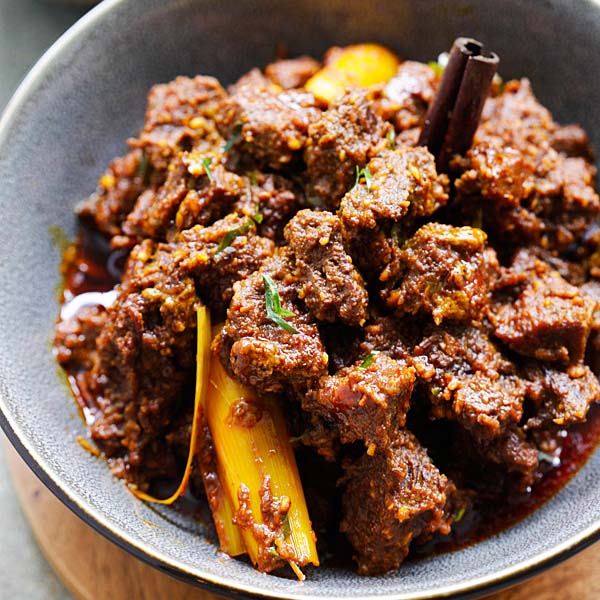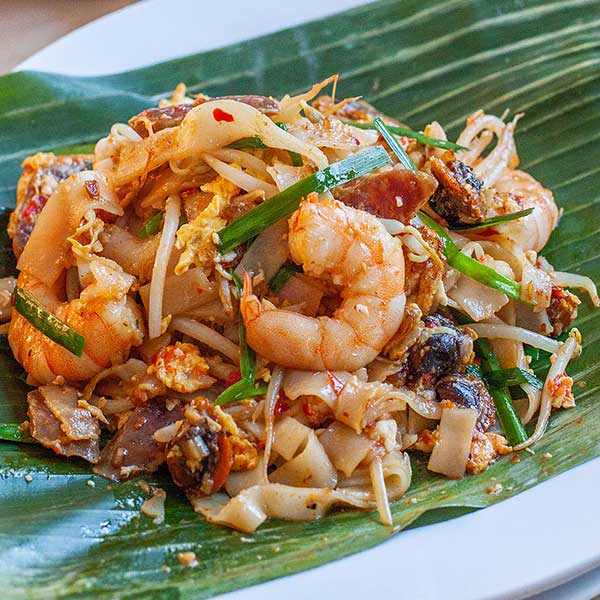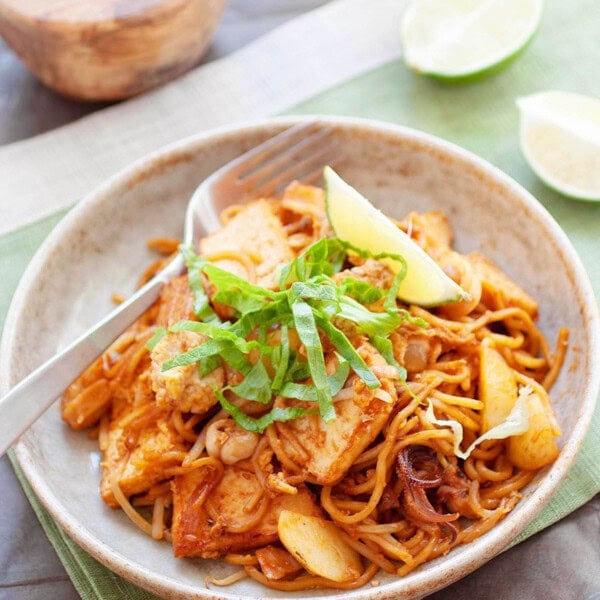This post may contain affiliate links. Please read my privacy policy.
Penang Hokkien Mee is a prawn noodle soup that’s a staple in Penang, Malaysia. You’ll find it at street stalls and hawker centers, enjoyed by both locals and visitors any time of the day. If you’re after the best and most authentic recipe, you’re in the right place!
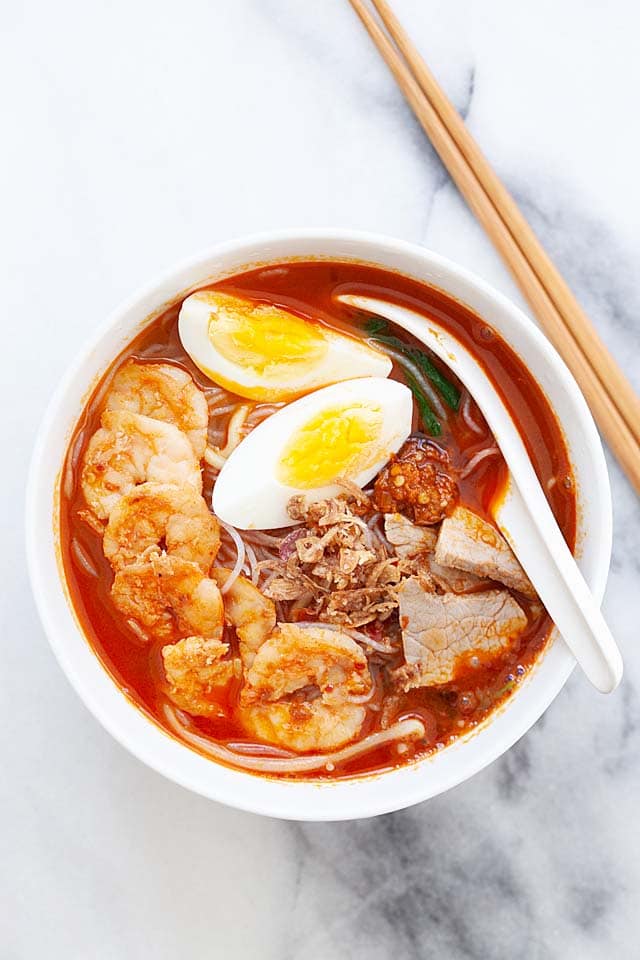
Hokkien Prawn Noodle Soup
Making this bowl of Penang Hokkien Mee (福建虾面) wasn’t something that happened overnight—it took months of dedication and patience. And I mean months, not days, and definitely not just a few hours.
To get that deep, signature flavor that makes this Penang hawker favorite so special, you need a serious stash of shrimp heads and shells. I’m talking about filling up a big Ziploc bag!
I love cooking with shrimp, but setting aside every head and shell for this dish? That takes some real commitment.
For more easy and delicious Malaysian noodle recipes, check out my Wonton Noodles and Nasi Lemak!
The Best Penang Hokkien Mee Recipe
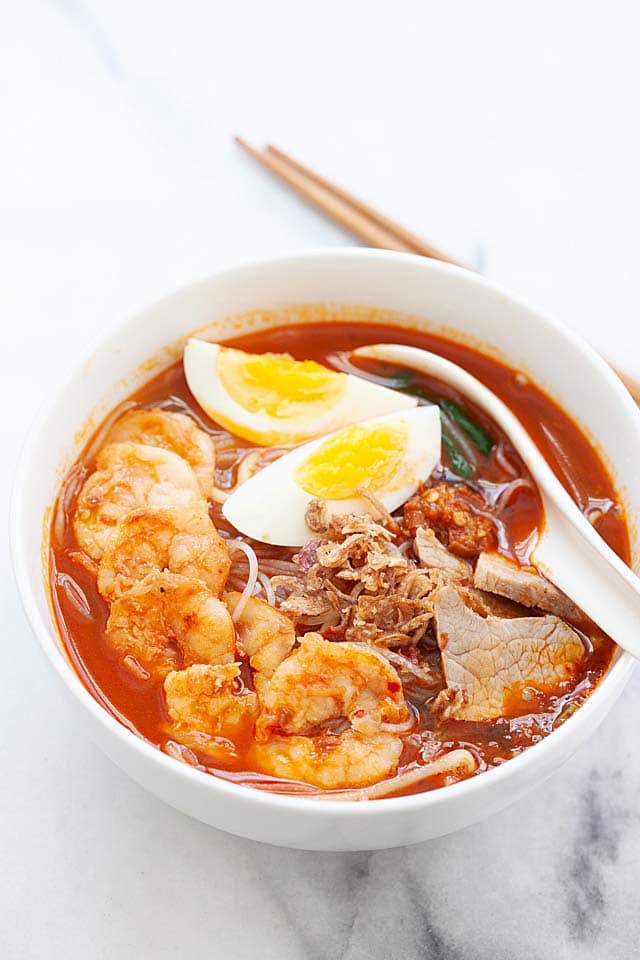
Good Prawn Mee is impossible to find here in the US, so I’ve been buying only head-on shrimp for months, patiently saving up every head just so I could make this at home.
Finally, this past weekend, my Ziploc bag was so full I couldn’t even zip it shut. That was my cue—I rushed to the nearest Asian supermarket and grabbed everything else I needed: shrimp, pork ribs, bean sprouts, noodles, and more.
The result? A pot of rich, prawny stock that tasted just like the ones from hawker stalls in Penang. Slurping up that flavorful soup with unlimited fall-off-the-bone pork ribs? Absolutely worth the wait!
The Origin Of The Dish
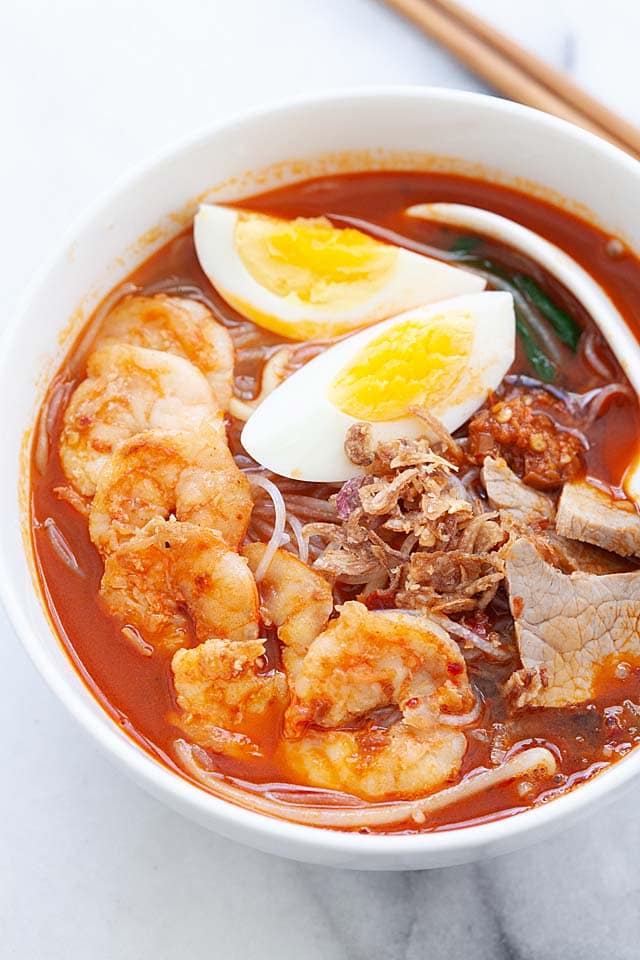
Hokkien Mee may be a famous Penang hawker dish, but its roots go back to Fujian, China—hence the name “Hokkien” (Fujian in the dialect) and “Mee” (meaning noodles).
When I visited Xiamen in early 2006, I saw this firsthand. Local coffee shops on the island had food stalls selling Fujian Xia Mian (福建虾面), their own version of prawn noodles. The taste was familiar, but let’s be real—Malaysia’s Hokkien Prawn Mee is on another level. It’s richer, spicier, and loaded with better ingredients and toppings.
Outside of Penang, this dish is also called Har Meen (Cantonese) or Heh Mee (Hokkien). And just to clear up any confusion—KL Hokkien Mee is a totally different dish. It’s a dark, soy sauce stir-fried noodle that comes from Kuala Lumpur, Malaysia’s capital city.
Frequently Asked Questions
I use dried red chilies from Asian grocery stores. For a good balance of heat and color, go with Chinese, Thai, or Indian dried chilies—Kashmiri chilies are great if you want a deeper red color. Just be sure to deseed and soak them before blending.
If you can find chili boh at the market, that’s the best and most authentic option. Otherwise, Adabi and Thai Kitchen chili pastes work well as substitutes.
Yes. You can make the prawn and pork stock a day or two ahead. Just let it cool completely before storing it in the fridge. When you’re ready to serve, reheat it until boiling, and you’re good to go.
Bring a pot of water to a boil, then add the pork and let it simmer for 20–30 minutes until cooked through. Take it out, let it cool a bit, then slice it thinly.
The deep red color comes from the shrimp heads and chili paste. If your soup looks pale, you probably didn’t use enough shrimp heads in the stock. I used one big Ziploc bag full, but you can definitely use more—the more, the better! Let them simmer long enough to extract all that rich color and flavor. Also, fry the chili paste until the oil turns red—that makes a big difference.
Keep the soup and toppings separate in the fridge. The broth stays good for about 3 days, but the shrimp, pork, and eggs are best eaten within 2 days. For the best texture, cook the noodles fresh when you’re ready to serve.
You can freeze the broth for up to 3 months. Just let it cool completely, then store it in an airtight container. When you’re ready to use it, thaw and bring it to a rolling boil before serving!
This recipe is only 405 calories per serving.
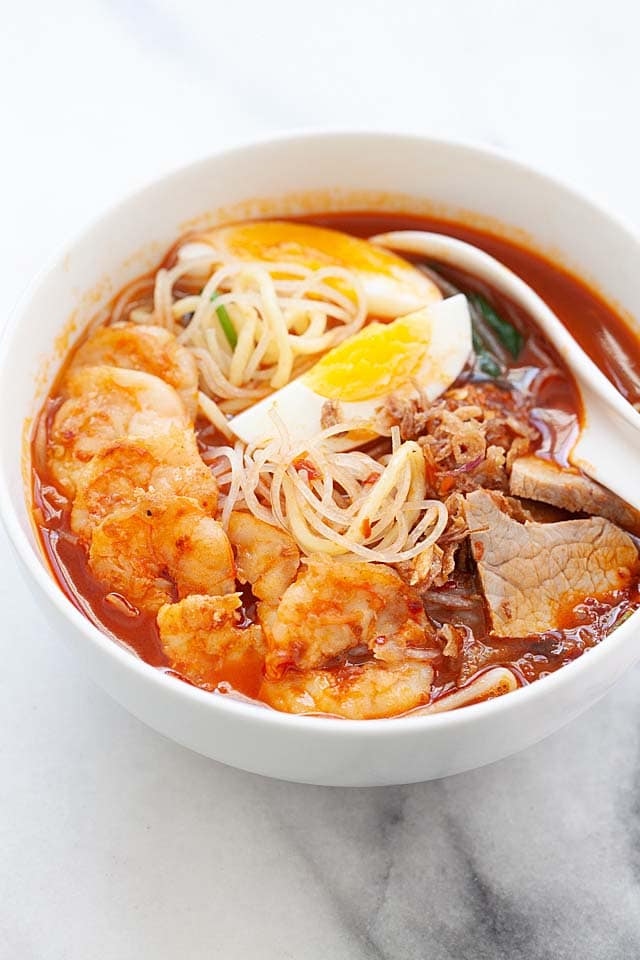
What To Serve With This Recipe
For a complete Penang street hawker food experience, I recommend the following recipes.
I hope you enjoy this post as much as I do. If you try my recipe, please leave a comment and consider giving it a 5-star rating. For more easy and delicious recipes, explore my Recipe Index, and stay updated by subscribing to my newsletter and following me on Facebook, Pinterest, and Instagram for new updates.
Other Recipes You Might Like

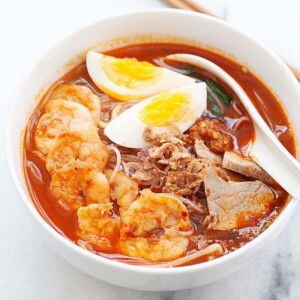
Penang Hokkien Mee
Ingredients
Stock:
- 1 bag shrimp heads and shells, Ziploc Easy Zipper Bag
- 15 cups water, reduced to about 12-13 cups of water after hours of boiling and simmering
- 2-3 pieces rock sugar, about the size of a small ping pong ball each, or to taste
- 1.5 lbs (750g) pork ribs, cut into pieces
- salt to taste
Chili Paste:
- 30 dried red chilies, seeded and soaked to soften
- 10 shallots, peeled
- 5 cloves garlic, peeled
- 2 tablespoons water
- 6 tablespoons cooking oil
- 1 pound (500g) yellow noodles, scalded
- 1 pack rice vermicelli, scalded
- kangkong , or water convolvulus, scalded
- bean sprouts, scalded
Toppings:
- 1/2 pound (250g) lean pork meat, boiled and sliced thinly
- 1/2 pound (250g) shrimp, shelled and deveined
- 6 hard-boiled eggs, shelled and quartered
- fried shallot crisps, store-bought
Instructions
- Blend the chili paste ingredients in a mini food processor until finely ground and well blended. Heat a wok and add cooking oil. Stir-fry the chili paste for 5 minutes. Remove from the heat and set aside.
- In the same unwashed wok, add a little oil and cook the shrimp topping. Then, add a small amount of chili paste, sugar, and salt. Pan-fry the shrimp until slightly browned. Remove from the heat, let them cool, and then slice them in half.
- Add 15 cups of water to a pot and bring it to a boil. Then, add all the shrimp heads and shells, and simmer on low heat for about 2 hours or longer, until the stock becomes cloudy and has an intensely prawn flavor.
- Strain the stock through a sieve and transfer it to another pot, discarding the shrimp heads and shells. Remove and discard any orange foam that forms on the surface of the stock.
- Bring the stock to a boil again and add half of the chili paste. You can add more chili paste if you prefer a spicier flavor.
- Add the pork ribs and continue to simmer over low heat for another 1 to 1.5 hours, or until the pork ribs are thoroughly cooked. Add rock sugar and salt to taste.
- To serve, place a portion of yellow noodles, rice vermicelli, water convolvulus, and bean sprouts in a bowl. Ladle hot stock over the noodles and vegetables. If desired, add a few pieces of pork ribs. Top with sliced pork, sliced shrimp, egg quarters, and sprinkle with shallot crisps. Serve immediately, and add more chili paste to taste if desired.
Notes
- Traditionally, the shrimp heads and shells are stir-fried with oil until aromatic before being added into the boiling water. You can opt for this extra step if you like.
- Hawkers in Penang also blend the shrimp heads and shells after briefly boiling them to extract all the flavors from the shells. I’ve tried this step before and found that it’s not necessary if you have plenty of shrimp heads and shells.
Nutrition
Nutrition information is automatically calculated, so should only be used as an approximation.
